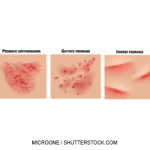 A recent study showed that patients with severe plaque psoriasis who were treated with ustekinumab had better retention rates than those treated with other biologic drugs.1 The researchers investigated biologic treatment drug survival rates in psoriasis patients and sought to identify predictors for drug survival rates. Drug survival is a term used to quantify the loss of drug efficacy over time. Such factors as patient adherence, patient expenditures, prescriber preference, adverse events and local healthcare regulation may affect a drug survival rate.
A recent study showed that patients with severe plaque psoriasis who were treated with ustekinumab had better retention rates than those treated with other biologic drugs.1 The researchers investigated biologic treatment drug survival rates in psoriasis patients and sought to identify predictors for drug survival rates. Drug survival is a term used to quantify the loss of drug efficacy over time. Such factors as patient adherence, patient expenditures, prescriber preference, adverse events and local healthcare regulation may affect a drug survival rate.
The survival analysis study included patients drawn from the Clalit Health Services (CHS) HMO (health maintenance organization) database, which is the largest public HMO in Israel, including data on more than 4.3 million individuals. Following Israeli guidelines for the biologic treatment of psoriasis, all patients met the following criteria: 1) their involved body surface area had to be greater than 50% or their Psoriasis Area and Severity Index (PASI) had to be greater than 50; 2) sensitive areas, defined as genitalia, palms, face, had to be involved; and 3) at least two prior standard systemic treatments had failed. According to the CHS internal guidelines, tumor necrosis factor inhibitors (TNFIs) (e.g., adalimumab, etanercept and infliximab) were used as first-line and second-line biologic treatments, unless absolutely contraindicated. TNFIs have been available to treat psoriasis in Israel since 2008. Ustekinumab is indicated after failure of two prior TNFIs as a third-line therapy.
A multivariate analysis was performed with modifications. During the study, 970 patients received 1,575 biologic treatments, and 865 patients discontinued treatment. Predictors of drug survival were concomitant methotrexate use and biologic naivety. Negative treatment predictors included being female and the duration of prior systemic treatment.
Ustekinumab had a significantly higher drug survival rate compared with other biologics (40.8 months). The other drug survival times were 26.4 weeks for adalimumab, 26.35 months for etanercept and 26.4 months for infliximab.
Michele B. Kaufman, PharmD, BCGP, is a freelance medical writer based in New York City and a pharmacist at New York Presbyterian Lower Manhattan Hospital.
Reference
- Shalom G, Cohen AD, Ziv M et al. Biologic drug survival in Israeli psoriasis patients. J Am Acad Dermatol. 2016 Dec 28. pii:S0190–9622(16)31008-8. doi: 10.1016/j.jaad.2016.10.033. [Epub ahead of print]



